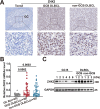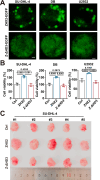Liquid-liquid phase separation of ZHX2 protects DLBCL cells against ferroptosis through induction of SLC3A2
- PMID: 40730912
- PMCID: PMC12463659
- DOI: 10.1038/s41375-025-02718-z
Liquid-liquid phase separation of ZHX2 protects DLBCL cells against ferroptosis through induction of SLC3A2
Abstract
Diffuse large B-cell lymphoma (DLBCL), the most common B-cell non-Hodgkin lymphoma (B-NHL), is characterized by strong aggression, high heterogeneity, and poor prognosis. Consequently, there is an urgent need to identify crucial therapeutic targets. Here, we found that the transcription factor zinc-finger and homeobox 2 (ZHX2) was highly expressed in DLBCL. Subsequently, ZHX2 was proven to be critical for promoting DLBCL cell proliferation by inhibiting ferroptosis. Mechanistically, ZHX2 bound to the promoter region of the solute carrier family 3-member 2 (SLC3A2) gene through liquid-liquid phase separation (LLPS) and activated its function to negatively regulate ferroptosis. Furthermore, we constructed lipid nanoparticles ZHX2-siRNA@LNP targeting DLBCL, which effectively inhibited the growth of the tumors in vivo. In summary, our study indicated that the LLPS of ZHX2 protected DLBCL against ferroptosis through induction of SLC3A2, and disturbing it with ZHX2-siRNA@LNP could significantly repress DLBCL, providing a promising therapeutic strategy for DLBCL.
© 2025. The Author(s).
Conflict of interest statement
Competing interests: The authors declare no competing interests.
Figures







References
-
- Pfreundschuh M, Schubert J, Ziepert M, Schmits R, Mohren M, Lengfelder E, et al. Six versus eight cycles of bi-weekly CHOP-14 with or without rituximab in elderly patients with aggressive CD20+ B-cell lymphomas: a randomised controlled trial (RICOVER-60). Lancet Oncol. 2008;9:105–16. - PubMed
-
- Salles G, Duell J, González Barca E, Tournilhac O, Jurczak W, Liberati AM, et al. Tafasitamab plus lenalidomide in relapsed or refractory diffuse large B-cell lymphoma (L-MIND): a multicentre, prospective, single-arm, phase 2 study. Lancet Oncol. 2020;21:978–88. - PubMed
-
- Poletto S, Novo M, Paruzzo L, Frascione PMM, Vitolo U. Treatment strategies for patients with diffuse large B-cell lymphoma. Cancer Treat Rev. 2022;110:102443. - PubMed
MeSH terms
Substances
LinkOut - more resources
Full Text Sources
Research Materials

